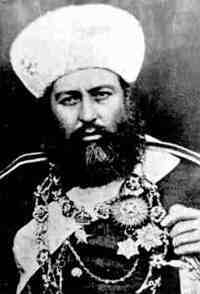1888–1893 Uprisings of Hazaras
The 1888–1893 Uprisings of Hazaras occurred when the Treaty of Gandomak was signed and the Second Anglo-Afghan War ended in 1880, causing Abdur Rahman Khan to set out on a goal to bring Hazarajat and Kafiristan under his control. He launched several campaigns in Hazarajat due to resistance from the Hazaras in which his forces committed atrocities. The southern part of Hazarajat was spared as they accepted his rule, while the other parts of Hazarajat rejected Abdur Rahman and instead supported his uncle, Sher Ali Khan. In response to this Abdur Rahman waged a war against tribal leaders who rejected his policies and rule.[1] Abdur Rahman arrested Syed Jafar, chief of the Sheikh Ali Hazara tribe, and jailed him in Mazar-e-Sharif.
First uprising
The first Hazara uprising against Abdur Rahman Khan took place between 1888 and 1890. When Emir Abdur Rahman's cousin, Mohammad Eshaq, revolted against him, tribal leaders of the Sheikh Ali Hazaras joined the revolt. The revolt was short lived as the Emir extended his control over large parts of Hazarajat.
After all of Sheikh Ali Hazaras' chiefs were sent to Kabul, opposition within the leadership of Sawar Khan and Syed Jafar Khan continued against the government troops, but at last were defeated. Taxes were imposed and Afghan administrators were sent to occupied places, where they subjugated the people with abuses.[1] People were disarmed, villages were looted, local tribal chiefs were imprisoned or executed, and the better lands were confiscated and given to Afghan nomads (Kuchis).[2]
Second uprising
The second uprising occurred in the Spring of 1892. According to Syed Askar Mousavi, the cause of the uprising was an assault on the wife of a Hazara Chieftain by Afghan soldiers. The families of both the man and his wife, deciding that death was one hundred times better than such humiliation, killed the soldiers involved and attacked the local garrison, from whence they recovered their confiscated arms".[1] Several other tribal chiefs who supported Abdur Rahman now turned against him and joined the rebellion which rapidly spread through the entire Hazarajat. In response to the rebellion, the Emir declared a "jihad" against the Shias[3] and raised an army of up to 40, 000 soldiers, 10, 000 mounted troops, and 100,000 armed civilians (most of which were Pashtun nomads).[1] He also brought in British military advisers to assist his army.[2]
Third uprising
| Crackdown on Third Hazara Uprising | |
|---|---|
 Abdur Rahman Khan cracked down on the uprisings with expulsion and massacre. | |
| Location | Hazarajat, Afghanistan |
| Date | 1893 |
| Deaths | 400,000 Hazaras[4] |
| Perpetrators | Afghan army under Abdur Rahman Khan |
| Part of a series on |
| Hazara people |
|---|
|
About · The people · The land · Language · Culture · Diaspora · Persecutions · Tribes · Cuisine Politics · Writers · Poets · Military · Religion · Sports · Battles |
The third uprising of Hazara was in response to the harsh repression; the Hazara revolted again by early 1893. This revolt took the government forces by surprise and the Hazara managed to take most of Hazarajat back. However, after months of fighting, they were eventually defeated due to a shortage of food. Small pockets of resistance continued to the end of the year as government troops committed atrocities against civilians and deported entire villages.[2]
Abdur Rahman's subjugation of the Hazara due to fierce rebellion against the Afghan king gave birth to strong hatred between the Pahstun and Hazara for years to come. Massive forced displacements, especially in Oruzgan and Daychopan, continued as lands were confiscated and populations were expelled or fled. Some 35,000 families fled to northern Afghanistan, Mashhad (Iran) and Quetta (Pakistan). Hazara farmers were often forced to give up their property to Pashtuns[5] and as a result many Hazara families had to leave seasonally to the major cities in Afghanistan, Iran, or Pakistan in order to find jobs and a source of income. Quetta in Pakistan is home to the third largest settlements of Hazara outside Afghanistan.
See also
References
- 1 2 3 4 "HAZĀRA: ii. HISTORY". Alessandro Monsutti (Online ed.). United States: Encyclopædia Iranica. December 15, 2003. Retrieved 2012-08-09. http://www.iranicaonline.org/articles/hazara-2
- 1 2 3 Mousavi, Sayed Askar (1998) [1997]. The Hazaras of Afghanistan: An Historical, Cultural, Economic and Political Study. Richmond, NY: St. Martin's Press. ISBN 0-312-17386-5.
- ↑ "Refworld | World Directory of Minorities and Indigenous Peoples – Afghanistan : Hazaras". Refworld. Retrieved 2016-01-16.
- ↑ "H A Z A R A G E N O C I D E ( 1 8 8 8 - 1 8 9 3 )". Wixsite.
- ↑ دلجو, عباس (2014). تاریخ باستانی هزاره ها. کابل: انتشارات امیری. ISBN 9936801504.